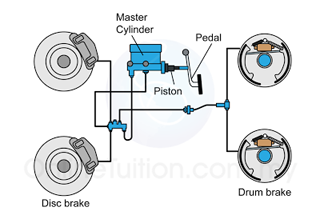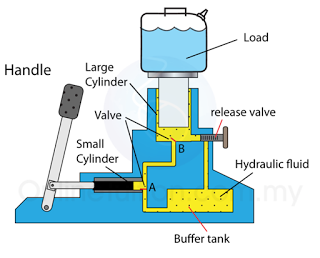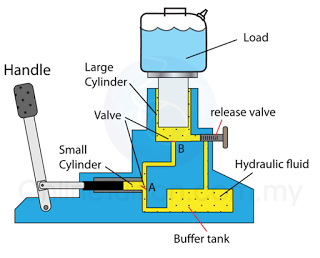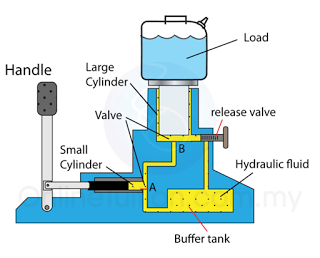Hydraulic Brake
In most vehicle, hydraulic system is used in the braking system, as shown in the figure below.

Usually, a disc brake is used in the front wheel of a car while a drum brake is used in the back wheel of a car.
Working Mechanism of Hydraulic Brake
- When the brake pedal is pressed, the piston of the master cylinder applies a pressure on the brake fluid.
- This pressure is transmitted uniformly to each cylinder at the wheel, cause the pistons at the wheels to push the brake shoes to press against the surface of the brake.
- The friction between the brakes and brake shoes causes the vehicle to slow down and stop.
Q & A
Q: Why is it dangerous if air bubble is trapped in the brake fluid of a braking system.A:
- If air bubble is present in the fluid, the fluid become compressible.
- This may prevent pressure transmits through the fluid and hence causing ineffective braking effect.
Q & A
Q: Why oil but not water is used as the hydraulic fluid in a hydraulic brake system?A:
- Because the boiling point of oil is much higher than water. This can prevent the hydraulic fluid from boiling when the brake is very hot.
- Water may cause rusting in the part of the braking system
Hydraulic Jack
Working mechanism of a hydraulic jack.
- When the handle is pressed down, valve A is closed whereas valve B is opened. The hydraulic fluid is forced into the large cylinder and hence pushes the piston moving upward.
-

- When the handle is raised, valve B will be closed while vale A will be opened. Hydraulic fluid from the buffer tank will be suck into the small cylinder.
-

- This process is repeated until the load is sufficiently lifted up.
- The large piston can be lowered down by releasing the hydraulic fluid back to the buffer tank through the release vale.
